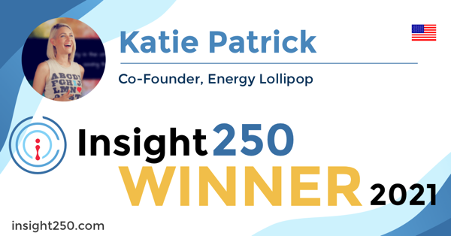


The Insight250 spotlights and celebrates 250 of the world’s premier leaders and innovators in market research, consumer insights and data-driven marketing. The inaugural list was revealed this April and created renewed excitement across the industry whilst strengthening the connectivity of the market research community.
With so many exceptional professionals named to the Insight250 it seems fitting to tap into their expertise and unique perspectives across an array of topics. This weekly series will focus on doing just that; inquiring about the expert perspectives of many of these individuals in a series of short topical features.
This edition features Katie Patrick, Environmental Engineer and Author of “How to Save the World” and Caroline Florence, Founder of Insight Narrator. Both these industry leaders are passionate about getting results, not just generating insights but bringing the data to life to drive change.
It never ceases to amaze me when I work with new organisations how much intelligence, how much insight, already exists but all too often it is siloed or forgotten, and not in the hands of those who could use it to drive change. Often, the most effective change comes when an insight is represented as a visualisation or transformed to a compelling story that captures the imagination. Martin Luther King’s “I have a dream” speech or the 1978 Saatchi & Saatchi “Labour isn’t Working” advertising campaign that propelled Margaret Thatcher to power demonstrate how a great metaphorical narrative or a captivating visual can capture imaginations. I talked to Caroline and Katie about making this happen.
Crispin: Katie, you are renowned for your cutting-edge visualisations that bring data to life. Can you discuss an example of one of your favourites?
Katie: “My favourite one is the Energy Lollipop which will come true in the coming weeks. It comes from the idea of a circular shaped light that is about one meter in diameter that sits on a stick, so it looks like a lollipop. It sits out on the street and discloses the real time carbon emissions of the electricity grid, which changes depending on the time of the day. The time when you use electricity is very important. Very few people understand this concept, so the idea of having a display on the street is that the information is publicly communicated. It’s similar to the idea of stock market activity being communicated on screens or weather being communicated. I think carbon emissions should be just as ubiquitous and public as those other types of numbers so they understand how their own behaviours impact the whole. This is known as community scale feedback. So that will be very exciting.”
Crispin: Caroline, copywriting skills are important too, what can researchers do to get better at getting their points of view across succinctly in the words they choose?
Caroline: “I think the research sector has come a long way in the last 10 years when it comes to data visualisation, and this has been helped by the various platforms that support this part of the job. I’d like to see the same energy and effort invested in language and writing skills. Remember, words have power. Words play a critical role in communicating our message. But most researchers I work with are not as conscious or deliberate with their copy as they could be. For me the 4Us is a great checklist for ensuring powerful copy – is it urgent, is it useful, is it unique and is it ultra-specific.”
Crispin: What can researchers learn from your approach to be more innovative in visualising data to drive action?
Katie: “People need to start designing from the behaviour first. A lot of the technology, visualisation or mapping tends to consider the product first and then the behaviours are considered at the end. Even I make this mistake at times. It’s really easy to get wrapped up in the app or data and then assume that people will act, so I go through a behaviour mapping process. I have written about this on my Medium page (katiepatrick.medium.com). You isolate your individual actor and then you go through a process of how they will travel through the process until they take an action. So how will an individual hear about something or what will cause them to take an action? This can change the entire design or landscape of what you are doing. Then you look at what data you are working with and what action you want them to take. Then you review the behavioural nudges that can motivate them to take that action, which can be colors, maps, social norms or pledges. You then look at the related rewards which can be as simple as a check-mark or smiley face. Then what is the measurable result when someone goes through this path?”
Crispin: Caroline, what can researchers learn from your storytelling training to help them put the skills into practice day to day?
Caroline: “The approach I take is that storytelling is a mindset and a way of working, not a task. If researchers come to storytelling expecting it to be an extra task that they can bolt on to the end of their projects after pulling together all their reports, they will struggle to achieve the impact required; by that point the hard work is done, we are close to the deadline and we run out of energy. Effective, and efficient, storytelling has to be weaved throughout the research process so our training focuses on a clear roadmap that identifies what story tasks to do when to produce a concise and compelling story.”
Crispin: What do you think is the biggest pitfall when presenting data to drive change and how is this overcome?
Katie: “I think the biggest pitfall is making it complicated. Everybody does this with so many charts and numbers and squishing them together. I try to have a philosophy of one number and one colour. It’s called cognitive load – don’t give people cognitive load, just make it effortlessly simple. If you open your eyes and count to three and then close your eyes and you don’t get it, it means your design is too complicated.”
Caroline: “I completely agree with Katie, brevity is key. We need to ruthlessly edit and strip out our ‘working out.” I audit so many reports and presentations where great insight is lost in the detail, making it hard work for the audience to interpret the two or three key critical messages they need to act on. We need to get off the fence and have conviction in our analysis and interpretation – focus on actionable insight messages, not the volume of findings.”
Crispin: Katie, you wrote the book How to Save the World, what inspired you to get into this area?
Katie: “I wanted to make an impact. I was working on a green media platform start-up and it had a directory of green services. I wasn’t sure if our content was making an impact. So, I created a little thermometer to show how much energy you were using. I started trying to build that and then realised there weren’t proper data feeds to access water and electricity usage, so I started looking into all of them, like waste, cars, natural gas, forest cover. It was all pretty tragically, pretty badly done. There really weren’t any APIs, maybe just pdfs and spreadsheets from government websites. I was also learning about behavioural psychology. I realised we had to get better at this. The most powerful way to get people to change is comparing them to each other. Calls to biosphere action don’t really work well, calls to money don’t work that well. Even calls to you to be a good person don’t work that well. But when you say hey you used 20 percent more than your neighbour, that works. So I was fascinated by that, so I jumped right down the rabbit hole of behavioural psychology and put it together with data.”
Crispin: I have to ask, where can people buy your book?
Katie: ”Visit my website katiepatrick.com. There are links there or you can go to Amazon and type in ‘how to save the world.’”
Crispin: Caroline, your focus on storytelling is very niche, what compelled you to focus on this above everything else?
Caroline: “Firstly, communication is what makes us human and is our main tool to influence others, so for me it is a vital component of what we do. Secondly, as an experienced insight professional I saw a lot of great work fall flat because it wasn’t cutting through or convincing others to act. I saw that as a personal strength of mine and felt that could be my best contribution to the sector that I love, to help others achieve impact.”
In conclusion, during his time as CEO of WPP’s Kantar, Eric Salama was renowned for his mantra of “better done than perfect.” In today’s world, where the demand is for everything to be, as Sir Martin Sorrell voiced: “better, faster, cheaper,” it is true that what is critical is for us to get actionable insights into the consciousness of those who will use them to deliver. Yes, we need to ensure our facts are true, our evidence supportable, but we also have to ensure it is understood and available. From talking to Caroline and Katie it is abundantly clear that the presentation of our insights (both HOW and WHERE) is critical in assisting that delivery. The onus is on us all to “bring our data to life”.
TOP TIP
Katie: Really deeply understand the hero’s journey. I never deviate from the hero’s journey. You can use it for a Hollywood feature film or one paragraph – it applies to anything. You say this is the current problem and look at the aspirational solution. Then you have objectives and then look at the mentor who can take you on the journey and how they are qualified. Then you cross the threshold and get to the happy ending. Unfortunately, a lot of climate communications say everything is doomed and it’s not taking you through this narrative. I have an article on this on my Medium page called How to Tell a Story that Changes the World.
Caroline: Remember that humans need more than numbers and logic to be motivated to act. Fluency of your argument is essential to aid understanding, but don’t forget the need for an emotional connection to the ask, whether that is shock, shame, excitement, contentment, reassurance or fear!


